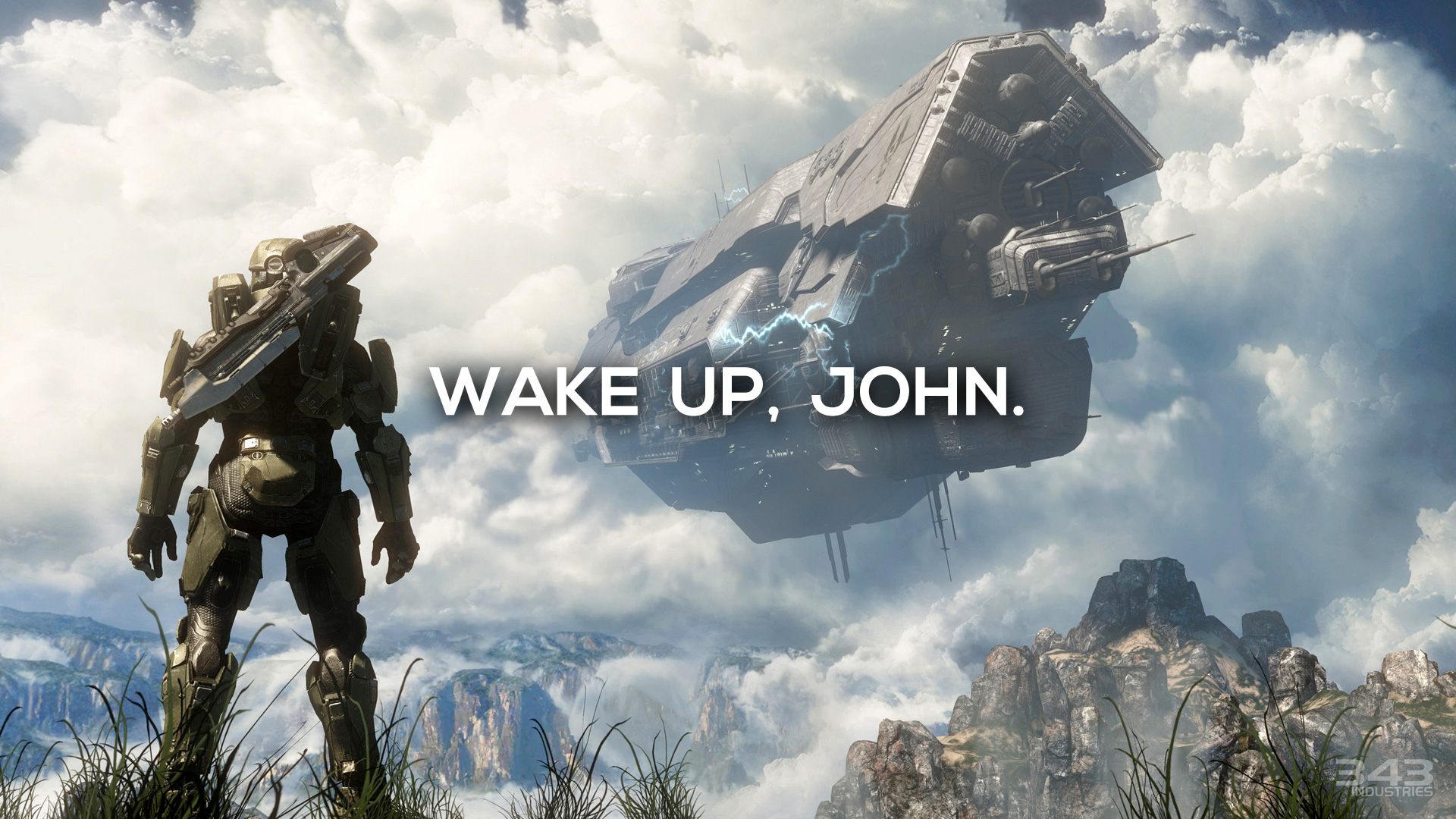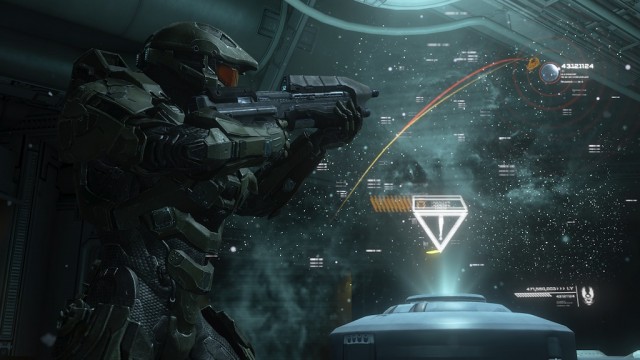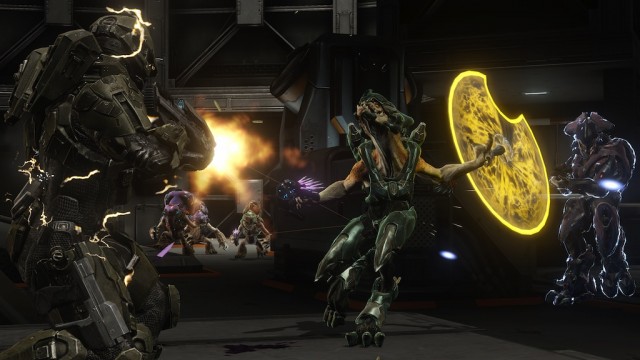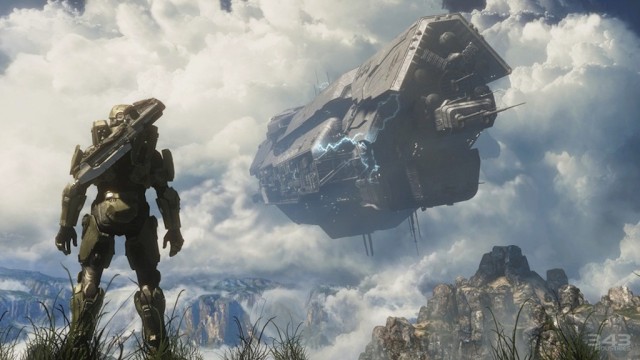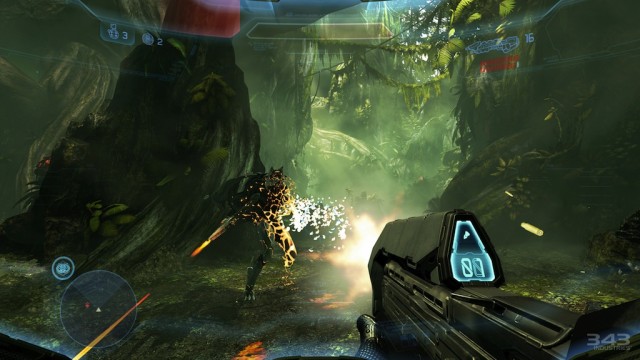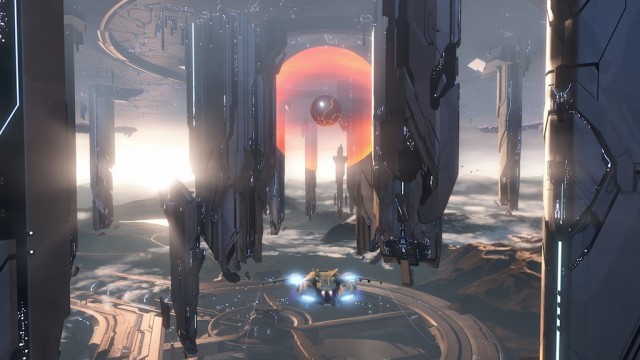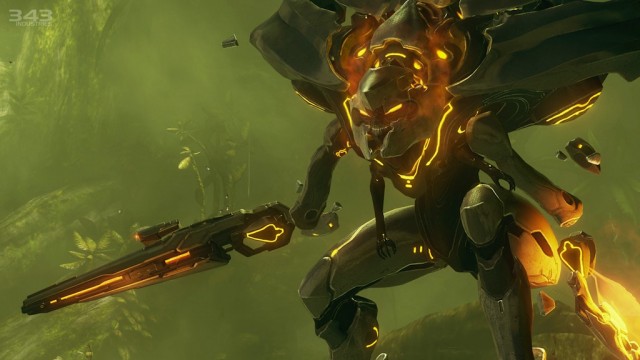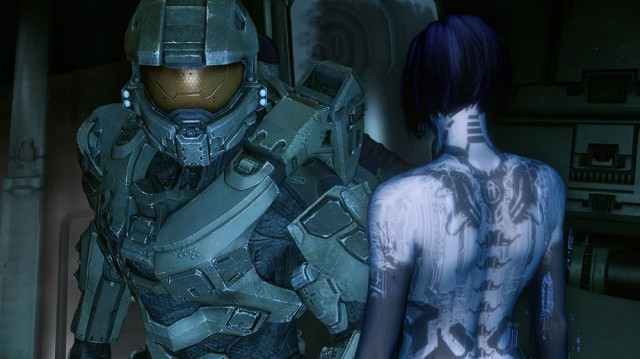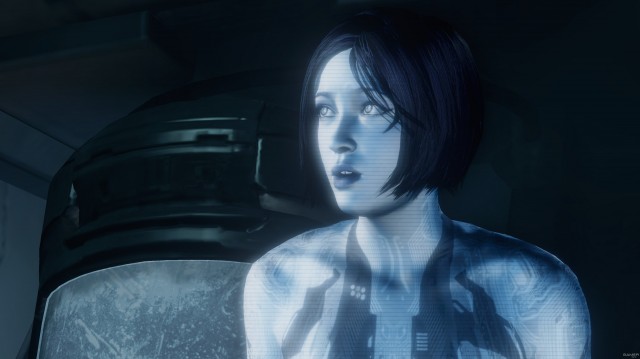John wakes up in this definitive review of the first entry in the Reclaimer Trilogy.
As you might expect, there are some spoilers ahead. Nothing major about the story, but a lot of gameplay details such that, if you haven’t played the game yet, we encourage you to come back after you have. Tread lightly, Spartan.
We can sum up each entry in the Halo franchise in one word. Combat Evolved would be, of course, “original”, while Halo Wars would be “strategic” and Halo 3: ODST would be “emotion.” What then, would be the word we use to describe Halo 4? For that, Cortana must awaken Master Chief.
Halo 4 begins with a cutscene that looks to be a mix of live action and computer graphics. You can see that some scenes aren’t real, yet others are quite obviously live action. Yet none of it is live action. That opening cutscene sets the stage for how beautiful Halo 4 looks, and the game instantly becomes the best looking game ever made, hands down. We would expect visuals like this on the next generation Xbox, and it is very exciting to think that if we have them on this console, we haveno idea what to expect from the true next generation of consoles.
As you know, Cortana awakens the Chief from cryo-sleep as the Forward Unto Dawn is being boarded by, well, something. Instantly, 343 Industries closes a story gap and explains the Chief’s new heads-up display, saying she rewrote his firmware while they’ve been floating through the ether. In one of the most satisfying lines in the game, Chief doesn’t miss a beat saying, “You’ve been busy.” And we’re right back into classic, beautiful Halo banter between our two beloved characters.
343 Industries has a lot of weight on their shoulders. They need to fulfill the expectations of years of Halo fans while improving upon the formula that made the original games so incredible. The team at 343 seem to have found a great way to do that, and it means truly understanding what made the first set of Halos so successful and more importantly, so much damn fun. From there, they put in some cheeky nods to the original gameplay mechanics and core story lines, later branching out to create their own piece of art.
The first level of actual gameplay treats you to classic Halo. Cortana leads you around a ship after being awoken to someone knocking at your door. For those not paying attention, that is also exactly how Halo: Combat Evolved started. Be aware, this is not a bad thing. In fact, it’s an incredible thing. Super fans will instantly recognize what 343 Industries did, crack a smile, and continue playing, because at its core, Halo 4 is the first game in a brand new series.
What we saw from the original unveil trailer at E3 2011 will give you nothing more than a minor glimpse into the first mission of Halo 4. And that is as it should be, because that was a teaser, and so is the first mission. You meet the covenant, kill a few of them, and proceed. Why are we fighting the covenant again? That, too, is explained in a way so simple it’s elegant: “A lot can happen in five years,” says Cortana.
Back to graphics. What makes Halo 4 look so great? You know, if we knew, we would tell you. It seems as if 343 managed to put an extra processor and a fresh bucketload of memory into our 360 because the game looks nothing short of stellar. It is a true masterpiece in looks and far and away the best looking game on any platform, ever. Animations are fluid and stunning, and the designers have incorporated many new assassinations in both campaign and multiplayer to highlight just how smooth they are.
At an early point in the game, after a massive strike, you see a covenant grunt struggling to crawl across the wreckage. No weapon, no hope even, just a lowly creature that is trying to stay alive. It is merely decoration, really, but if you notice it, you’ll be blown away. Here is this timid creature just trying to survive and you can’t help but feel sorry for him even though your reticle is red when you point your weapon at him.
Stunning details don’t stop there, as you will quickly notice the incredible use of light and some of the best looking shadow physics we’ve ever seen in a game. Cutscenes and the game itself are rendered beautifully, and the cutscenes feature some of the most accurate facial and lip movement from any game we can think of. It truly is a sight to see.
Of course graphics are not the only piece of the Halo 4 puzzle. Almost all of the in-game audio has been re-recorded from scratch to give it more realistic, beefier, and intense sounds. Weapons and effects are spectacular as they arrive with a huge thud and knock you over the head with their force. The sound of the new yet old assault rifle makes it so that it seems even more powerful than it actually is, and the sound of a plasma grenade exploding is still unique to this game and only this game.
The soundtrack of Halo 4 has also been completely redone, and while it doesn’t have he same instant familiarity of Marty O’Donnell’s themes from the Bungie games, these themes are just as epic and empowering as anything that came before 343 Industries’s game. Halo 4‘s soundtrack is some of the best music we’ve heard in any game. It won’t make you emote quite the same way Halo 3: ODST did, and it probably won’t get you as pumped as you were in the thick of things on Reach, but it is still a stellar arrangement and should be heard.
Graphics and audio are all well and good, but there needs to be gameplay and story to back them up. We’ll be succinct here: 343 Industries executes on both marks with incredible precision.
In the gameplay department, 343 makes some very smart moves. First off, they stay true to classic gameplay mechanics but modify them to fit the structure of their game in their own way. For example, Halo 4 is a difficult game. We played through on normal and we weren’t constantly dying, but we had a bit of a challenge with some of the newer enemies. In past Halos, you could almost always run and gun your way through a big batch of enemies. 343 Industries made it so that, while there isn’t any cover system in place, you need to be more strategic with your actions as you control the Chief. You can run and gun if you’re really good, but don’t expect that to get you out of every situation.
Another box ticked is the variety of gameplay, and the way it is spread evenly across the game. 343 didn’t leave all the big toys to the end of the game. We get to fly banshees and pilot ghosts within the first hour of gameplay, as well as command Scorpion tanks and turrets moments later. There are some other awesome tech set pieces, too, but we won’t spoil those here. There are a few new mechanics like crawling and clubbing, but these amount to just a few moments of slower paced quick-time events of sorts, even though they manage to retain most of the fun that normal quick-time events tend to discard.
343 purposely used a light hand with new game mechanics, sprinkling Halo 4 with a few new ways to play, testing the waters, and giving us a craving for more. They were smart and didn’t rely on entirely new mechanics to make the game what it is, and it pays off. We want more.
Dispensing with enemies is an extremely satisfying part of Halo 4, as it should be given that it is the core gameplay mechanic in the game. The audio certainly doesn’t hurt, as perfectly tuned needles form a super-combine against the new Promethean enemies. Killing in Halo 4 is phenomenally well balanced and very satisfying. Some enemies explode on headshot, wounding nearby foes as well, which makes killing in groups very satisfying.
A new gameplay mechanic 343 introduced this time around is pelican flying. This is something we’ve been wanting since we first flew into the beach on The Silent Cartographer on the first ring back in 2552. Unfortunately, it’s probably our biggest problem with the game. For one, the design of the pelican we actually get to fly is decidedly un-pelican. Controlling the ship for the scarce few moments that we actually get to fly it is also such. The ship is far too maneuverable for what is supposed to be a dropship, not a fighter. This was our biggest disappointment, if only because we built the pelican-flying moment up so much in our heads that it probably couldn’t have been a success no matter what 343 did.
There are other unique missions that involve vehicles that are far better than the pelican fiasco, however. At one point near the end of our adventure, we are treated to a Skywalker-like Death Star Trench Run, although with a broadsword as opposed to an X-Wing. We have a feeling LucasFilm, or rather, Disney, wouldn’t like it too much if 343 borrowed one of Star Wars‘s most iconic vessels. This is where we assumed the end of the game would be, leaving us with a Halo 2-like cliffhanger ending, but 343 does a great job of tricking us into thinking the game is longer than it is by giving us lots of gameplay after this point.
Unfortunately, that is probably our other gripe with Halo 4: its length. There are eight missions in the game, a few short of the usual ten to twelve we got from Bungie’s titles. Then again, the quality and diversity in gameplay on each level is remarkable in Halo 4 and we are certainly bigger fans of quality than we are of quantity. With that said, it would have been nice to have a little more than six hours in the campaign. Note that we’re only discussing the campaign here and we will discuss multiplayer when the game goes live next week, as it is a bit hard to judge the game when there are only a handful of play testers, fellow media, and thieves (you know who you are) playing the game right now.
Of those six hours we spent with the Chief in Halo 4, every single one was fun. We had some of the best moments in gaming out of any series in the history of gaming. There were some missions that devolved into hitting three switches, travelling to the other side of the cavern, and hitting another three switches, but these moments were rare and happened more to pay homage to the original games than to artificially lengthen the game.
As familiar as some sections of the game was, the new enemies, as well as the return of some older ones, always changed up the gameplay. The new promethean enemies are badass, to say the least. Ranging from watchers to knights to crawlers, prometheans are as deadly as they are orange. They truly feel like a new enemy to defeat as you have to adjust your likely stay and spray attitude you used to dispense of covenant forces in previous games. Knights, in particular, are difficult to defeat as they have a tendency to disappear as well as be helped by their counterpart, the watcher. We’d rank them up there with sword-wielding elites as they are decidedly difficult to destroy.
Unfortunately, the covenant in Halo 4 feel like an oversight. They feel easy to defeat because you can continue to use your stay and spray attitude from previous games. Elites are still elites and grunts are still grunts. While they look better in terms of character models, the strategy to defeat them remains the same. Shoot, and shoot often.
And that brings us to story. The story in Halo is probably our favourite component, even though many people buy the game without ever cracking the campaign, instead opting to play multiplayer only. We hope those people at least hop into the first few missions of Halo 4 for its incredible campaign and astounding depth.
As you may have heard, Halo 4 has very little to do with Master Chief and everything to do with Cortana. Sure, you control the chief, but as Cortana’s artificial intelligence degrades and she begins to think herself to death, the emphasis on her story and her emotion deepens to an incredible degree. Our jaws dropped more than once, as the emotion Cortana emitted from her terminal was more human than some real-life people we know and see every day.
Of course, she drops a line: “Don’t make a girl a promise you can’t keep.” It’s a bit different from the original line in Halo 3, perhaps reflecting 343 Industries’s desire to change some components of the game yet striving to keep the right components intact.
Halo 4 is such a story-driven game, and it has evolved properly from a story-driven game into a story-driven game. Yes, you read that right. See, Halo games are only first-person shooters because that was the vessel Bungie chose to deliver its story. Halo Wars was a great game because it continued to delivery a quality, emotional story in a different way, using a real-time strategy engine as its vessel. Halo is a game you play to discover.
Within Halo 4‘s story, we struggle with not only the concepts of life and loss, but also death. We see the slow degradation of Cortana and how it affects her as well as Master Chief.
For the first time in a Halo game, we see that corrupt characters also exist on the human side of the story, with a couple of UNSC characters getting in the way of the Chief and his primary objective of saving humanity. It makes the story even more of a beautiful, real, human story. It plays out like a movie; you see a character very close to you, know they are going to delay you or get in your way – perhaps betray you – yet you have to grit your teeth and watch it all play out right in front of you. It’s a gripping way to tell a story as conflict emerges in Halo 4, as it does in life, from all sides.
Cortana really is at her end. With another two games in the Reclaimer Saga trilogy, it is very scary to know that so much of her end is focused on in this entry in the series. It’s more than just a glossed-over bullet point, though. 343 Industries makes it very clear that the idea of artificial intelligence deteriorating over time is a very real possibility. Cortana explains rampancy as her brain exponentially thinking and thinking and expanding on her thoughts until she literally thinks herself to death. At one point, she explains, in very scientific terms, no less, that she has 4000 reasons why the sun on the planet Requiem is not real, yet she doesn’t know whether or not it feels real. It is in this moment that we realized as much as we love Cortana and treat her as human, she is not.
In a stunning arc over the course of the game, we realize that roles are reversed as Master Chief becomes the voice of reason and logic when Cortana can no longer do it for them. It’s a beautiful reversal of the mechanic from previous games and very scary to think of how it all plays out.
At this point, we’d rather not reveal any more spoilers than are already present here. Given how much we have said, we can say that we haven’t done much more than scratch the surface on all the content in Halo 4‘s campaign. We will mention that 343 managed to pay many homages to Bungie’s entries in the franchise, each in its own way. The pelican flight sequence looks like a daytime version of Reach‘s New Alexandria mission, as does the way Master Chief straps a bomb to his back. The original calibration and release from cryogenic chamber at the beginning of the game is also reflective of the first game, as is the visit to an actual Halo ring in the final hours of the game, keeping the game’s name more relevant than just the first few games would have you believe. We’ve come full circle in that respect. Pun intended.
343 Industries has shown some incredible ingenuity. They’ve managed to create a game that pays tribute to the games before it, yet change just the right things to make the game all its own in their own way. Halo 4 is an incredible work and one hell of a first entry in a new trilogy bearing the Halo name.
It is unfair to call Halo 4 just 343’s first attempt at a game even though it is their first real project. Any developer on the planet should be nothing short of thrilled if Halo 4 was their swan song, let alone their first kick at the can. Halo 4 needs to be experienced because of the way it not only pays tribute to past Halo games, but also becomes its own. 343 Industries has proven that they know what parts of Halo make it a great game and what parts to update and improve upon. They’ve set the bar very high and we can only hope they have their sights set even higher as they plan to outdo themselves with the next iteration in the franchise.
Halo 4 in a word: Authentic.

